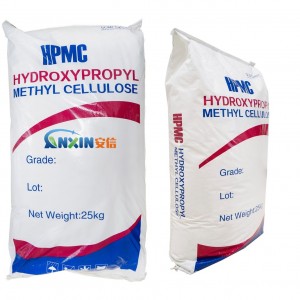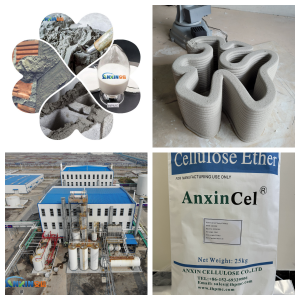1. HPMC Overview
Hydroxypropyl methylcellulose (HPMC) is a nonionic cellulose ether commonly used as a water-retention thickener and workability improver in mortar. In mortar systems, it not only adjusts rheology and working time but also directly or indirectly affects the hardened mortar strength. This effect is closely related to the HPMC dosage, degree of substitution, viscosity, formulation, and working conditions.
2. The Positive Effect of HPMC on Mortar Strength
2.1. Improving Cement Hydration Efficiency
HPMC’s strong water-retention properties reduce water loss during mortar construction, especially under conditions of high temperature, strong winds, or absorbent substrates. This ensures full hydration of cement particles. Complete hydration results in the formation of denser hydration products (such as C-S-H gel) in the mortar, which helps improve both early and later strength.
2.2. Reducing Segregation and Bleeding
Uneven distribution of cement and aggregate in mortar can lead to weak interfacial zones after hardening. HPMC increases system viscosity, reduces aggregate settling and water uptake, thereby improving microstructural uniformity and enhancing overall structural strength.
2.3. Improving Interfacial Bonding
During the hydration process, HPMC forms a uniformly distributed polymer film, which interacts with cement hydration products to enhance the mechanical and chemical adhesion between the mortar and the substrate. This not only improves bond strength but also indirectly enhances overall compressive strength.
2.4. Reducing the Risk of Shrinkage Cracks
By retaining water and slowly releasing heat of hydration, HPMC can reduce premature shrinkage cracking in the mortar, ensuring uniform stress distribution and avoiding localized stress concentrations that can lead to strength loss.
3. Potential Negative Impacts of HPMC on Mortar Strength
3.1. Excessive Use Leads to Strength Loss
HPMC is an organic polymer and does not participate in the cement hydration reaction. If added in excessive amounts, it can form a large organic phase within the hardened mortar, reducing the effective density of the inorganic binder and potentially resulting in a decrease in compressive strength.
3.2. Retarding Cement Hydration Rate
HPMC’s adsorption may coat the surface of cement particles, hindering water diffusion and delaying the hydration reaction. This retarding effect delays early strength development. Although it can be partially restored later, it is unfavorable for applications requiring rapid strength (such as rapid repair mortars).
3.3. Air Entrainment Effect
Some high-viscosity HPMCs tend to introduce microbubbles during mixing, increasing the air content of the mortar. If these bubbles are not destroyed, they form pores after hardening, reducing compressive strength.
4. Key Factors Affecting the Hydration Rate
4.1. HPMC Degree of Substitution and Viscosity
Higher degrees of substitution and higher viscosities of HPMC have stronger water retention, but also more pronounced hydration retardation and air entrainment effects.
Low-viscosity varieties have less impact on flowability and workability, and the risk of strength loss is lower.
4.2. Dosage Control
The typical HPMC dosage in dry-mix mortar systems is 0.1% to 0.3% of the cementitious material mass. Exceeding this range can easily result in a decrease in strength.
4.3. Formulation System
When containing redispersible polymer powder (RDP), the synergistic effect of HPMC and RDP can significantly improve flexibility and adhesion, and has a positive effect on flexural strength.
In lightweight or porous aggregate systems, HPMC’s water retention is even more critical, significantly slowing strength loss.
4.4. Construction and Curing Conditions
HPMC’s positive effect on strength is more pronounced in high temperature, low humidity, or high wind conditions. Conversely, in humid environments and when the substrate is non-absorbent, its water retention advantage is less pronounced, and excessive dosage may even negatively impact strength.
5. Optimization Recommendations
5.1. Accurate Dosage Control
While ensuring workability, use the lowest effective dosage possible to avoid excessive organic phase that can reduce strength.
5.2. Use with Defoamers
To address air entrainment issues with high-viscosity HPMC, add an appropriate amount of defoamer to reduce air bubbles and porosity.
5.3. Synergistic Use with Other Additives
Combined with redispersible polymer powders, lignin sulfonates, and other additives, it can improve strength and durability while maintaining workability.
5.4. Adjusting the Formulation for the Application
For tile adhesives and plaster mortars, prioritize bonding strength and workability, while compressive strength can be sacrificed to some extent.
For structural repair mortars, the HPMC dosage should be reduced to maintain early strength.
HPMC has a dual impact on mortar strength: appropriate dosage and appropriate grade can enhance the overall structural density and durability of the mortar, while excessive dosage or inappropriate grade can reduce strength. Scientific selection and dosage control are key to leveraging the advantages of HPMC while avoiding its negative effects.
Post time: Aug-12-2025

